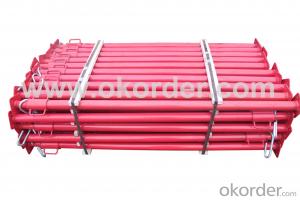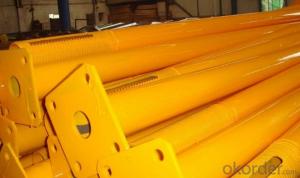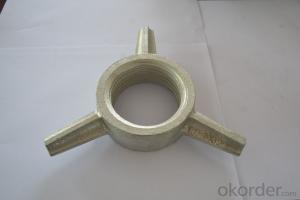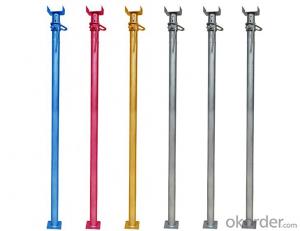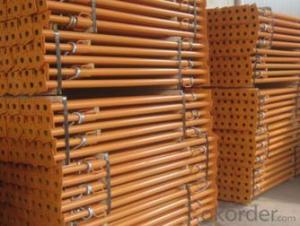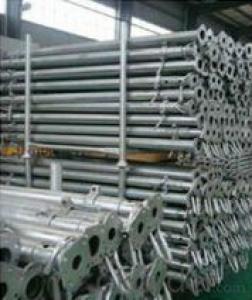U Head Scaffolding Steel Prop
- Loading Port:
- China Main Port
- Payment Terms:
- TT OR LC
- Min Order Qty:
- -
- Supply Capability:
- -
OKorder Service Pledge
OKorder Financial Service
You Might Also Like
Quick Details
| Brand Name: | Finish: |
Packaging & Delivery
| Packaging Detail: | Pallet |
| Delivery Detail: | within one month |
Specifications
Ringlock System
1. Vertical,Ledger,Transom,Diagonal Brace,Base Jack
2. EG, Dip Painting,HDG
3. Pallet Package
4.Q235,Q345
Ringlock System
1. Vertical,Ledger,Transom,Diagonal Brace,Base Jack
2. EG, Dip Painting,HDG
3. Pallet Package
4.Q235,Q345
Ringlock Scaffolding
Widely welcome around the world
Ringlock System is composed by Standard, Transom, Ledger;Diagonal Braces, board,etc...
We have a capability of 1000 Metric tons per month
We can supply Dip Painting Surface, HDG Surface and EG Surface
| Ringlock component | Specification (mm) | Weigtht (kg) | Material |
| Standards with Spigot | 500 | 3.09 | Q235/Q345 |
| 1000 | 5.49 | ||
| 1500 | 7.90 | ||
| 2000 | 10.30 | ||
| 3000 | 15.11 | ||
| 3500 | 17.51 | ||
| Ledgers | 750 | 3.20 | Q235 |
| 1000 | 4.07 | ||
| 1065 | 4.31 | ||
| 1200 | 4.78 | ||
| 1500 | 5.88 | ||
| 2000 | 7.56 | ||
| 2200 | 8.30 | ||
| 2500 | 9.35 | ||
| 3000 | 11.13 | ||
| Ladder | 3000 | 17.80 | Q235 |
| Braces | 750x2000 | 9.18 | Q235 |
| 1000x2000 | 9.47 | ||
| 1500x2000 | 10.31 | ||
| 2000x2000 | 11.40 | ||
| 2500x2000 | 12.67 | ||
| 3000x2000 | 14.06 |
Type of shoring props:
Shoring entails the construction of a temporary safety structure to prop up walls in a building that has become unstable due either to foundational expansion or natural disaster. The type of shoring a contractor chooses will depend on a specific building's structural status and the circumstances surrounding the building's weakness.
- Q:Can steel props be used in the construction of oil and gas facilities?
- Yes, steel props can be used in the construction of oil and gas facilities. Steel props, also known as adjustable steel props or steel shoring props, are widely used in construction projects to support temporary structures and provide stability. These props are specifically designed to bear heavy loads and are made from high-quality steel, ensuring durability and strength. In the construction of oil and gas facilities, steel props can be utilized for various purposes. They can be used to provide temporary support during the installation of equipment, such as pipelines, tanks, or platforms. Steel props can also be employed to stabilize structures during maintenance or repair work, ensuring worker safety and preventing any potential structural damage. Moreover, steel props are adjustable, allowing for easy customization to fit the specific requirements of the oil and gas facility construction. They can be extended or retracted to reach the desired height or length, providing flexibility in adapting to different construction scenarios. Additionally, steel props offer advantages such as quick installation and dismantling, cost-effectiveness, and reusability. These factors make them a preferred choice in the construction industry, including oil and gas facilities, where time, budget, and efficiency are crucial. However, it is important to note that the use of steel props in oil and gas facilities must comply with safety regulations and industry standards. Proper engineering analysis and design considerations should be undertaken to ensure the props are used correctly and safely in such sensitive environments.
- Q:What is the steel plate support
- If it is embedded - embedded iron.If the structure is used as steel stairs - metal structure item set
- Q:Can steel props be used in the construction of hotels?
- Steel props, also known as steel shoring or steel support systems, are widely employed in the construction industry, including hotel construction. These props serve as temporary supports during the construction process, providing stability and safety to structures. They are easily adjustable and can be conveniently installed and removed, making them an ideal choice for construction projects necessitating temporary support. In hotel construction, steel props play a crucial role in supporting the weight of concrete slabs, walls, and other building components. Additionally, their adaptability in terms of height adjustment makes them suitable for a variety of construction scenarios and requirements. In summary, steel props are a dependable and extensively utilized tool in the construction industry, including the construction of hotels.
- Q:Can steel props be used in the construction of offshore platforms or oil rigs?
- Indeed, offshore platforms or oil rigs can make use of steel props during their construction. Commonly employed in construction projects, steel props offer support to temporary structures like formwork or scaffolding. Their primary purpose is to provide vertical support and stability during construction activities. In the case of offshore platforms or oil rigs, steel props find application in supporting various components such as decks, modules, or equipment during the construction phase. By distributing the weight of these structures, steel props ensure their stability even in the harsh offshore environment. Steel props are favored in offshore construction due to their capacity to bear heavy loads, durability, and resistance to corrosion. They are typically crafted from high-strength steel and engineered to withstand the demanding conditions encountered offshore, including strong winds, rough seas, and corrosive saltwater. Moreover, steel props can be easily adjusted and adapted to accommodate changes in the construction process or provide additional support where necessary. Their modular design enables swift installation and removal, making them a practical choice for offshore construction projects that demand flexibility and efficiency. However, it is essential to note that the utilization of steel props in offshore platforms or oil rigs is typically confined to the construction phase. Once permanent structures are in place, steel props are no longer necessary and are usually dismantled. The permanent structures themselves are designed to provide the required support and stability during the operational phase of the offshore platform or oil rig.
- Q:Are steel props suitable for supporting temporary exhibition structures?
- Temporary exhibition structures can be effectively supported by steel props. These props, also referred to as adjustable steel columns or acrow props, are commonly utilized in the construction field to provide temporary support for structures during building or renovation projects. Their purpose is to offer stability and strength, which makes them an excellent choice for supporting temporary exhibition structures. Steel props possess great versatility and can be easily adjusted to accommodate different heights and loads. They are constructed from durable steel materials, ensuring stability and reliability. Furthermore, steel props have a remarkable load-bearing capacity, enabling them to support a wide range of structures, including exhibition displays and installations. In addition, steel props offer exceptional structural support, allowing for the secure and safe installation of temporary exhibition structures. They can be swiftly assembled and disassembled, making them a convenient option for temporary installations that require frequent changes or reconfigurations. Moreover, steel props have undergone extensive testing and meet the industry's safety and performance standards. They are designed to withstand heavy loads and create a stable foundation for exhibition structures, guaranteeing the safety of both the structure itself and its visitors. In conclusion, steel props are an appropriate solution for providing support to temporary exhibition structures. Their durability, adjustability, and high load-bearing capacity make them an ideal choice for ensuring stable and secure support for exhibition displays and installations.
- Q:Can steel props be used in the installation of temporary signage or banners?
- Yes, steel props can be used in the installation of temporary signage or banners. Steel props are commonly used as supports for various structures, including temporary ones like signage or banners. They provide stability and strength, ensuring that the signage or banner is securely in place. Steel props can be easily adjusted to the desired height and are resistant to weather conditions, making them suitable for outdoor installations. Additionally, steel props can be reusable, making them a cost-effective option for temporary signage or banners.
- Q:What are the different sizes and lengths of steel props available?
- Adjustable steel support props, also referred to as steel props or steel shoring props, are utilized in construction projects to provide temporary support for structures like formwork, scaffolding, and falsework. They are available in a range of sizes and lengths to accommodate different construction needs. Manufacturers and project specifications can influence the sizes and lengths of steel props. However, the market generally offers commonly used sizes and lengths. Sizes: 1. Size 0: This is the smallest size and is commonly utilized for lighter loads and applications. It features an adjustable range of approximately 1.04 meters to 1.83 meters. 2. Size 1: This size is popular for general construction purposes and can support medium loads. The adjustable range for size 1 props typically falls between 1.75 meters and 3.12 meters. 3. Size 2: Heavier loads and larger construction projects often require size 2 props. Their adjustable range usually extends from 1.98 meters to 3.35 meters. 4. Size 3: Designed for heavy-duty applications, size 3 props can support significant loads. Their adjustable range typically spans from 2.59 meters to 4.01 meters. Lengths: Steel props also come in various lengths to offer flexibility in construction projects. The available lengths range from a few meters to several meters, depending on the manufacturer and project specifications. It is essential to note that the mentioned sizes and lengths are common examples and may vary based on the manufacturer and specific project requirements. Consulting with a professional engineer or supplier is always recommended to determine the appropriate size and length of steel props for a particular construction project.
- Q:How do you maintain a steel prop?
- To keep a steel prop in good condition, there are several important steps you can take: 1. Keep it clean: Prevent the build-up of dirt, dust, and debris by regularly cleaning the prop. Use a mild detergent and warm water to gently scrub the surface. Avoid using harsh chemicals or abrasive cleaners that can harm the steel. 2. Prevent rust: Steel is prone to rust, so it's crucial to take preventive measures. Apply a rust inhibitor or protective coating to create a barrier between the steel and moisture. Regularly check for signs of rust and address it immediately by removing the rust and applying a rust converter or primer. 3. Lubricate moving parts: Hinges and joints may need lubrication for smooth operation. Use a suitable lubricant like silicone-based or graphite lubricant to minimize friction and maintain functionality. Follow the manufacturer's recommendations for lubrication frequency and application. 4. Regularly inspect: Periodically examine the prop for damage, wear, or loose components. Look for cracks, dents, or bent areas that could compromise its structure. If any issues are found, consult a professional for repair or replacement. 5. Store properly: When not in use, store the prop in a dry, well-ventilated area away from direct sunlight and extreme temperatures. Consider using a protective cover or case to prevent dust and accidental damage. Remember, proper maintenance is crucial for the longevity and safe use of a steel prop. By following these steps, you can ensure that your prop remains in excellent condition and performs optimally for a long time.
- Q:Can steel props be used for temporary support in underground structures?
- Yes, steel props can be used for temporary support in underground structures. Steel props are strong and durable, making them suitable for providing support during construction or maintenance work in underground environments. They can effectively bear the load and provide stability to the structure until permanent supports are installed.
- Q:How do you prevent damage to adjacent structures when using steel props?
- When using steel props, there are several measures that can be taken to prevent damage to adjacent structures. 1. Conduct a thorough survey and assessment: Before using steel props, it is essential to conduct a detailed survey of the surrounding area. This should include identifying any adjacent structures, utilities, or sensitive areas that may be at risk of damage. Assess the condition of these structures and determine their load-bearing capacity. 2. Ensure proper installation and positioning: Steel props should be installed and positioned correctly to provide adequate support. This involves following the manufacturer's instructions and guidelines, ensuring that the props are securely fastened and properly aligned. It is crucial to check for any obstructions or uneven surfaces that may affect the stability of the props. 3. Use appropriate load-bearing capacity: Make sure to select steel props with the appropriate load-bearing capacity for the specific application. Overloading the props can lead to structural failure and potential damage to adjacent structures. Consult with structural engineers or experts if necessary to determine the correct load-bearing capacity required. 4. Monitor and inspect regularly: Regular monitoring and inspection of the steel props during the construction process are essential. This includes checking for any signs of movement, deformation, or stress on the props or adjacent structures. Any abnormalities should be addressed immediately to prevent further damage. 5. Implement protective measures: Depending on the situation, additional protective measures may be necessary to prevent damage to adjacent structures. This can include using structural shoring, bracing, or strengthening techniques to distribute the loads more evenly and minimize any potential impact on surrounding structures. 6. Communication and coordination: Open communication and coordination with the project team, including adjacent property owners, is crucial. Informing them about the construction activities, potential risks, and mitigation measures will help minimize any potential damage and ensure everyone is prepared and aware of the situation. Ultimately, preventing damage to adjacent structures when using steel props requires careful planning, proper installation, regular monitoring, and the implementation of protective measures. Following these steps will help maintain the safety and integrity of both the construction site and the surrounding structures.
1. Manufacturer Overview |
|
|---|---|
| Location | |
| Year Established | |
| Annual Output Value | |
| Main Markets | |
| Company Certifications | |
2. Manufacturer Certificates |
|
|---|---|
| a) Certification Name | |
| Range | |
| Reference | |
| Validity Period | |
3. Manufacturer Capability |
|
|---|---|
| a)Trade Capacity | |
| Nearest Port | |
| Export Percentage | |
| No.of Employees in Trade Department | |
| Language Spoken: | |
| b)Factory Information | |
| Factory Size: | |
| No. of Production Lines | |
| Contract Manufacturing | |
| Product Price Range | |
Send your message to us
U Head Scaffolding Steel Prop
- Loading Port:
- China Main Port
- Payment Terms:
- TT OR LC
- Min Order Qty:
- -
- Supply Capability:
- -
OKorder Service Pledge
OKorder Financial Service
Similar products
New products
Hot products
Related keywords



